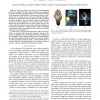Free Online Productivity Tools
i2Speak
i2Symbol
i2OCR
iTex2Img
iWeb2Print
iWeb2Shot
i2Type
iPdf2Split
iPdf2Merge
i2Bopomofo
i2Arabic
i2Style
i2Image
i2PDF
iLatex2Rtf
Sci2ools
ICRA
2009
IEEE
2009
IEEE
Model adaptation with least-squares SVM for adaptive hand prosthetics
— The state-of-the-art in control of hand prosthetics is far from optimal. The main control interface is represented by surface electromyography (EMG): the activation potentials of the remnants of large muscles of the stump are used in a nonnatural way to control one or, at best, two degrees-of-freedom. This has two drawbacks: first, the dexterity of the prosthesis is limited, leading to poor interaction with the environment; second, the patient undergoes a long training time. As more dexterous hand prostheses are put on the market, the need for a finer and more natural control arises. Machine learning can be employed to this end. A desired feature is that of providing a pre-trained model to the patient, so that a quicker and better interaction can be obtained. To this end we propose model adaptation with least-squares SVMs, a technique that allows the automatic tuning of the degree of adaptation. We test the effectiveness of the approach on a database of EMG signals gathered from ...
| Added | 23 May 2010 |
| Updated | 23 May 2010 |
| Type | Conference |
| Year | 2009 |
| Where | ICRA |
| Authors | Francesco Orabona, Claudio Castellini, Barbara Caputo, Angelo Emanuele Fiorilla, Giulio Sandini |
Comments (0)

